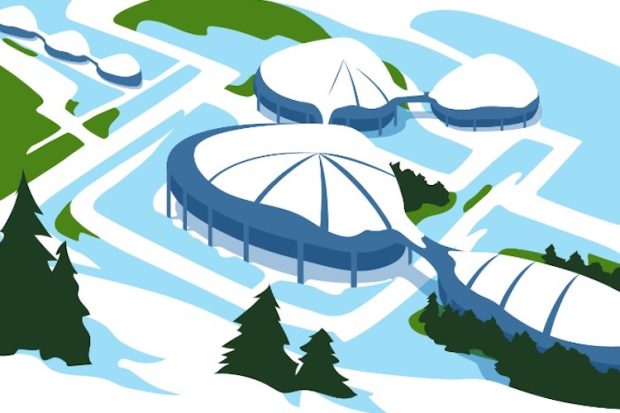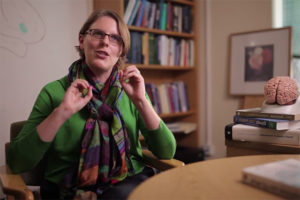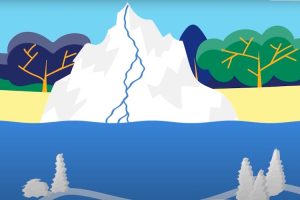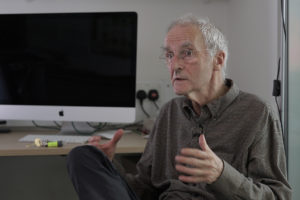Imitation
Social neuroscientist Antonia Hamilton on social connotations of imitation, copying silly actions, and mockery
In the middle of the 19th century, a man called Louis Agassiz was looking at the geology in the Alps. He concluded that the valleys that he was seeing and looking at and a lot of the landforms that were around in the Alps were evidence of the whole valley being occupied by ice: the landscape was formed by the action of ice at the time that was quite a strange thing to say because the general idea was that landscape had been given to us by God. So what he was saying was that that wasn’t necessarily true and that physical processes were responsible for that action. He toured around Europe, telling people what he found, convincing them one by one. Even Charles Darwin was a convert to his theory: he first thought that the landscape was indeed given to us by God, but he changed his mind after seeing the evidence.
The evidence of former glaciers in Europe and North America is evident for everybody to see. You don’t need to go very far to see valleys formed by the action of ice where there is no longer any ice. Glacial theory was established as an idea: the idea that the world once had a lot more ice in it: an ice age. By the end of the 19th century, it was pretty well accepted that the Earth had experienced an ice age in the past. But we wanted to understand what caused the ice age.
A Serbian mathematician, Milutin Milankovitch, in the middle of the 20th century, picked up the idea and added some refinements to it. Again, everyone thought this was a pretty good idea: it explains the glacial theory and all to do with the way the Earth orbits around the Sun and the amount of sunlight that we would get from the Sun as a consequence of those orbits. Unfortunately, he died with no one believing his theory either.
It took until the late 1960s and the ice core at Vostok station to make both theories that were previously accepted. The ice in Antarctica is a time machine. Snow falls on the surface of Antarctica, and that’s all fine, and people understand that. So when you have a snowball, it’s pretty light; it’s got a lot of air in it. However, in the middle of the Antarctic, at the very middle where Vostok station is, there’s very little sideways flow of ice. Most of the flow is downwards due to the burial of snow by subsequent snowfall.
So as that snow gets buried deeper and deeper into the ice, at a certain stage about 70 years after it was once deposited as snow, the air within the snow gets cut off from the atmosphere above. That snow turns into ice but the air in it retains as bubbles within the ice, and it gets deeper and deeper and deeper.
The ice beneath Vostok station is 3,700 meters thick, and the ice at the bottom of that was deposited 450,000 years ago. So if you have an ice core and you drill down all the way to the bottom of the ice at Vostok station, you pull it back up, and you sample the air within it, you actually sample the actual air that existed all that time ago and every year in between. We have a continuous, direct measurement of the Earth’s atmosphere and its constituents, the composition for the last 450,000 years. It’s a remarkable thing. And when you look at the way that the Earth’s atmosphere changes and there were various ways we could reconstruct temperature from that, you see the types of change are exactly what James Kroll and Milutin Milankovitch have proposed. It’s too much to be a coincidence. So, all of a sudden, the idea of orbital variations around the Earth causing ice ages was accepted again.

But the reason that Milankovitch and Kroll weren’t believed is that the solar changes they were proposing are very, very small, a few per cent in terms of heat coming in from the Sun. People were saying that can’t possibly cause ice ages, and it’s true: that’s not enough to cause an ice age. But what those early researchers weren’t appreciating was that the Earth doesn’t work as a series of feedback processes. The Vostok ice core demonstrated that it was carbon dioxide that was the big driver of the change. The carbon dioxide level recorded in the Vostok ice core goes from about 180 ppm during ice ages to 280 ppm, and 200 years ago, that’s what the level of carbon dioxide in the atmosphere was on Earth; right now, that’s what it should be.
So carbon dioxide is a big driver: where it’s low, you have less greenhouse gas, colder temperatures, ice ages, and when it’s high, like 280 ppm, it’s warmer temperatures and interglacial conditions. Ice ages are passed by the orbital variations around the Sun, but they’re driven by the carbon dioxide content. That’s what we’ve learned from the Vostok ice core, and that’s what we’ve learned about ice ages.
Where we’re now with carbon dioxide levels? Since 1850, we’ve been burning fossil fuels at an industrial rate to fuel industrialisation and mechanical processes and the way that we transport ourselves around the world. Carbon dioxide levels now stand at 403.5 ppm: that’s over a hundred more than they should be. The last time we had that level of carbon dioxide in the atmosphere was in a period in time called the Pliocene, 3.5 million years ago. Sea levels were 15-20 meters higher, and global temperatures were 3-4 degrees higher than they are right now.
This is why we have to worry about carbon dioxide in the atmosphere and global warming because if we do nothing about it, that’s where we’re headed: we’re headed to global temperatures 3 or 4 degrees higher than they are now and sea levels over 10 meters higher than they are now. It might take a while to get there but that’s the destination.
When you extract an ice core, it’s like three kilometres long. You do it in bits, of course, and those bits of ice core are taken into a laboratory, and they are sliced into very thin layers. Those bits of ice are then looked at for their chemical composition: apart from water, what else is in the ice? And there will be air bubbles within that ice, and those air bubbles can be sampled. There’ll be dust in the ice, and that dust can be measured. Everything can be measured. These are very valuable samples, and it costs a lot of money to get an ice core. So we do a very thorough investigation of every single little bit of the ice that we extract, and what it tells us is important information about the atmosphere and what it was during the time that that ice was once snow falling on the surface of the Antarctic Ice Sheet. It tells us about the dust that was in there, it tells us about methane that’s in the atmosphere, it tells us about carbon dioxide, and it tells us about the isotopes of oxygen. Everything that we would want to understand about how Earth’s climate has changed in the past is encapsulated within a little bit of ice buried beneath the surface of Antarctica.
Ice cores tell us about the long-term history of our climate from ice ages to between ice ages, but they also tell us about more short-term variations as well. In particular, Greenland also has very big ice sheets, and it’s three or four kilometres thick in places.
And what the Greenland ice cores tell us is that at some times in the last 10-20 thousand years ago Earth’s climate changed by plus or minus 5°С over course of just a few decades.
The reason for that is that water coming off the melting ice sheets in North America during deglaciation was interrupting the heat transfer in the North Atlantic, the thermohaline circulation. The world’s oceans flow in an interconnected way is driven by salinity salt changes in the North Atlantic, and if you put fresh water into the North Atlantic, you stop that flow of heat. And if you stop the flow of heat, then Great Britain and other parts of Northwest Europe suddenly become much much colder. That’s what the ice cores in Greenland have demonstrated. The Earth’s temperature around northwest Europe changes from plus or minus 5°С over just a few decades. This tells us that when you melt the ice if that meltwater goes into the North Atlantic, we can change the local climate significantly.
It’s undeniable that glaciers are retreating; all the glaciers around the world are largely retreating, and it’s undeniable that the ice in Antarctica and Greenland is experiencing some loss as well.
So sea level is going to go up, and it’s likely sea level will go up by half a meter in this century irrespective of what we do. The challenge for society is to stop the level of sea going up by more than that.
If we don’t tackle climate change, if we don’t stop greenhouse gas emissions and the world’s temperature warmers by 3-4°С, then we won’t just get a meter of sea level rise: we’ll get much more than that. And it won’t just be finishing this century: it will be going on for the next several centuries as well.
So what we’re looking at here, people living on this planet right now, we have a big choice to make. We can do nothing, and then our future generations will have to deal with the consequences of that in terms of a warmer world and one with sea levels much higher, or we can do something. We can change our ways, we can reduce greenhouse gas emissions, and we can stop the effects of climate change from being as severe as they might be. We can’t change them all; it’s already too late for some things: The sea level is going up half a meter by the end of this century; it’s extremely likely, but we can stop it being worse than that.
We’re the first generation to know that climate change is happening, that people are responsible for climate change and that we can do something about it. No other generation before us had that three bits of information. There’s just us.
If we don’t do something about it, in history, we won’t look so good. This is our greatest challenge, and we have all the skills available to do something about it. We’ve got all the predictions available to tell us why we need to do something about it, but it’s up to us to do it.

Social neuroscientist Antonia Hamilton on social connotations of imitation, copying silly actions, and mockery

The new research suggests that deep water layers may have played a role in ending the last glacial period in t...

Geneticist Steve Jones on the history of genetics, protein diversity, and why every person is truly unique